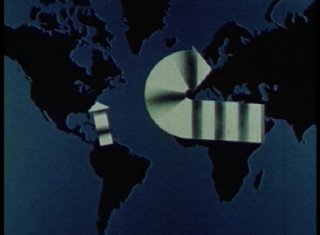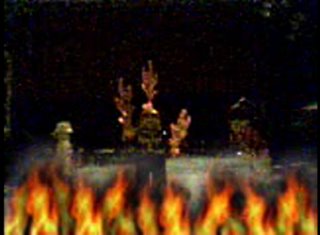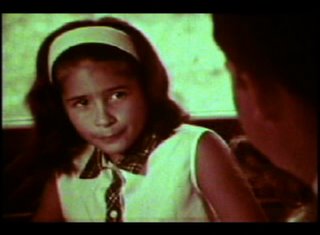
Reviews of film ephemera, including such things as educational films, industrial films, military and propaganda films, tv commercials, movie trailers, shorts, experimental films, and movies made for non-mainstream audiences.
Alice Gets in Dutch (film #3 on Disc 1 of Disney Rarities DVD (Disney, 2005)). [Category: Hollywood]
Alice gets in trouble at school for participating in a prank involving a balloon and a bottle of ink, and so has to sit in the corner with a dunce cap on her head. There she falls asleep and has a dream about jamming with some barnyard animals. The jam session is interrupted by the Evil Cartoon Teacher and her evil anthropomorphic textbooks and the inevitable war ensues. Superior firepower is ultimately overcome by creativity and a junk pile. This cartoon is a great deal of fun, featuring delightful characters, excellent acting by the girl playing Alice, and wonderful soundtrack music that enhances the action on screen. Kudos to Disney for digging these “Alice” toons up and restoring them so well. For 20s toons, they hold up remarkably well today.Ratings: Camp/Humor Value: ****. Weirdness: *****. Historical Interest: *****. Overall Rating: *****.
Children of Japan (in the Ephemeral section of Open Video Project. Also, film #314 on Prelinger Archive). [Category: Educational]
Considering the year this was made, 1941, I at first thought it was a WWII propaganda film. But no, this is a charming children’s educational film made just before the war about life in Japan. We follow two siblings, Taro and Yukiko, as they go through their day with their family, at school, and going to a cherry blossom festival. It looks pretty realistic, though in simplified form, about Japanese life at the time, and everything seems peaceful and well-ordered. Look at all those strange but nice people from another culture, children! Don’t be afraid––they may seem different to us, but deep down they’re really like you and me. How quickly that would change! In fact, I wonder if this film got any showing in classrooms at all, considering how quickly its tolerant message became outdated. I could swear I saw the scene of Japanese boys practicing fencing at school in a later propaganda film. Here, it’s shown as another charming Japanese cultural practice, but in the other film it was shown as proof of Japanese indoctrination of children in military values. Overall, this is an interesting snapshot of our attitudes towards the Japanese just before we went to war with them.Ratings: Camp/Humor Value: *** (gets an extra star for the fact that it just begs for msting about Godzilla). Weirdness: ***. Historical Interest: *****. Overall Rating: ***.
Beulah (film #6 in The Beulah Show section of TVParty). [Category: Early Film & TV]
This clip from the early 50s sitcom “Beulah” features Oriole, Beulah’s vapid neighbor, in a stereotyped performance that is painful to watch today. Let this serve as a reminder of what we don’t want to go back to.Ratings: Camp/Humor Value: ****. Weirdness: ****. Historical Interest: *****. Overall Rating: ****.
Batman (film #13 in the 1966 ABC Fall Preview section of TVParty). [Category: Commercial]
Campy, brief clip from the 1966 ABC fall preview show featuring Batman and Robin doing their schtick. Lots of fun if you like your Batman campy.Ratings: Camp/Humor Value: ****. Weirdness: ****. Historical Interest: ****. Overall Rating: ****.
Adullam (film #10 in the Rural Settlement and Security section of the State of Israel section of Stephen Spielberg Jewish Film Archive). [Category: Sleaze & Outsider]
Short 50s film in Hebrew documenting the settlement and development of Adullam, one of Israel’s frontier areas. This is pretty straightforward footage of surveying, building, and planting, and though I can’t understand Hebrew, I somehow suspect the narration contains few surprises. Some cool-looking model buildings provide a few moments of interest in the middle of the film, though.Ratings: Camp/Humor Value: *. Weirdness: *. Historical Interest: ***. Overall Rating: **.
The Big Moment (film #10 in the Jewish Communities section of Stephen Spielberg Jewish Film Archive. Also, film #12 in the Rural Settlement and Security section of the State of Israel section of Stephen Spielberg Jewish Film Archive). [Category: Public Service]
This 50s film uses Hollywood stars and filmmaking techniques to solicit contributions for the United Jewish Appeal. Robert Young narrates three stories about fictional displaced Jewish people who are helped by agencies funded by the United Jewish Appeal. The stories are fairly touching, though in a Hollywood way. Somehow Donna Reed fails to be convincing as a displaced Jewish woman on an Israeli settlement. I’m not sure, though, whether a more documentary approach would have been more effective, as the Hollywood approach certainly has emotional appeal. The film is an interesting historical record of how charitable funds were solicited during the 50s, as well as being an interesting anomaly from a time when anti-Semitism was acceptable, though nice people didn’t talk about it much.Ratings: Camp/Humor Value: ***. Weirdness: ****. Historical Interest: *****. Overall Rating: ****.

Air Head Videos (film #302 on Open Source Movies). [Category: Outtakes & Obscurities]
Look, Ma! I can make my Lego guys do tricks! And to disco music! That’s basically the point of this brief brickfilm, which means there’s not much point to it, but it’s lively.Ratings: Camp/Humor Value: ***. Weirdness: ***. Historical Interest: ****. Overall Rating: ***.

Coal Strike Ended (film #132 on Universal Newsreels). [Category: News]
40s newsreel reporting the end of a coal strike. Everybody is happy and cheerful, but you just know this is a temporary lull in a long struggle between labor and management. Some striking scenes of miners going underground are included. This is followed by a story about Catholic charities sending food to starving people overseas, including some interesting footage of food packing and shipping. This is one to mine for a video project.Ratings: Camp/Humor Value: **. Weirdness: ***. Historical Interest: ****. Overall Rating: ***.
Adventure in Freedom (film #8 in the Holocaust section of Stephen Spielberg Jewish Film Archive). [Category: Military & Propaganda]
This 50s film documents a Norwegian rehabilitation program for “hardcore DPs,”: holocaust survivors who could not rebuild their lives because of old age, disease, or disability, and thus were left to a depressing existence in displaced-person camps, a final insult to those who had already suffered so much. The Norwegian program chose some of the more promising of these people and gave them various forms of rehabilitation that helped them become eligible for resettlement and employment. This is an inspiring story, but the fact that only a small portion of the DP population could be helped this way lends a rather depressing note to things. Most holocaust stories end at the end of the war; this film provides a historically important look at the long-term aftereffects of it for many survivors.Ratings: Camp/Humor Value: N/A. Weirdness: ***. Historical Interest: *****. Overall Rating: ****.
Daring Daylight Burglary (film #29 on The Movies Begin, Volume Two: The European Pioneers (Kino Video, 1994)). [Category: Early Film & TV]
A burglar breaks into a house, but is spotted by a witness who informs the police, leading to a fight on a rooftop (where one officer is injured) and an extended chase. Unlike most early films of this type, this is pretty exciting and realistic, without any laughable moments. You can see how it may have influenced The Great Train Robbery. A 1903 Sheffield film.Ratings: Camp/Humor Value: *. Weirdness: **. Historical Interest: *****. Overall Rating: ****.

Death to Weeds (in the Ephemeral section of Open Video Project. Also, film #411 on Prelinger Archive). [Category: Industrial]
That’s right, death to weeds! Kill ‘em all!! They’re EVIL!! That’s the attitude of this Dow Chemical film from the 50s. Certain plants are labeled “weeds” by human beings and are thus deserving of death by chemical means. And the film shows us how effectively Dow insecticides blast them off this mortal coil for good. Granted, some of the plants shown are genuinely problematic, but the strident note of this film gets to you after awhile. Like some of the fly control films made at the same time, you start to feel a sense that the bright, clean 50s world could only exist through diligent efforts to root out impurities growing underfoot, such as flies, weeds, dirt, and Communists. Organic food lovers and environmentalists will find this film upsetting. Plant-haters will delight in all the scenes of gruesome plant death and the ending declaration that all weeds, everywhere, must be eradicated by chemical means.Ratings: Camp/Humor Value: ****. Weirdness: ****. Historical Interest: *****. Overall Rating: ****.
Commando Duck (film #8 on Disc #1 of Walt Disney on the Front Lines DVD (Disney, 2004)). [Category: Military & Propaganda]
For some reason, cowardly Donald Duck is sent on a commando mission to single-handedly wipe out a Japanese air base. Hi-jinx ensue, of course, but, amazingly enough, he is eventually successful. This is one of the liveliest and funniest Disney toons I’ve seen, though it does have more racist Japanese stereotypes than Bugs Bunny Nips the Nips. I want the pocket-sized “Emergency Boat” for the Film Ephemera Museum of Quirky Devices (they should make condoms out of that kind of rubber!).Ratings: Camp/Humor Value: *****. Weirdness: ****. Historical Interest: *****. Overall Rating: *****.
Adventures in Music: Melody (film #15 on Disc 1 of Disney Rarities (Disney, 2005)). [Category: Hollywood]
An owl teaches a class of songbirds about melody. Contentwise, this is full of 50s clichés and stereotypes, but visually, this is delightful, featuring innovative forms of 50s cute-style animation. As usual with Disney, this is beautifully preserved, which is especially important as the color usage in this cartoon is stunning. Wish we could see something this visually arresting in movie theaters today.Ratings: Camp/Humor Value: **. Weirdness: ****. Historical Interest: *****. Overall Rating: ****.
Abbott and Costello – Who’s on First (film #1 on The Colgate Comedy Hours, Vol. 1 DVD (Media Movies & More). [Category: Early Film & TV]
This episode of the early 50s variety series “The Colgate Comedy Hour” features Abbott and Costello in Washington, DC for the inaugural banquet for Eisenhower. As you might expect, havoc ensues, culminating with the ball turning into a brawl. The highlight of this, though, is a very funny performance by Victor Borge. Also fun are Abbott & Costello’s classic “Who’s on First” routine and a routine involving a trained mule who didn’t perform exactly as planned, requiring lots of ad-libbing, since the show was live. The show has a real early 50s feel to it, making it a good example of early live tv.Ratings: Camp/Humor Value: ****. Weirdness: ****. Historical Interest: *****. Overall Rating: ****.
Barbarella Trailer (film #2 on Barbarella DVD (Paramount, 1999)). [Category: Commercial]
I’ve never really liked this movie or this trailer. It’s supposed to be campy fun, but I just don’t care for the fact that they took what could have been an interesting female superhero character and turned her into a bimbo. 14-year-old boys will like this; others perhaps less so.Ratings: Camp/Humor Value: *. Weirdness: **. Historical Interest: ***. Overall Rating: *.
Acre – The Old New City (film #1 in the Cities section of the State of Israel section of Stephen Spielberg Jewish Film Archive). [Category: Sleaze & Outsider]
Spanish film from the 50s profiling the Israeli city of Acre, showing how modernization co-exists with ancient structures and traditions. Since this is all in Spanish, it’s a little hard to follow, but it still has some historical value, providing visual images of an Israeli city in the early years of Israeli independence.Ratings: Camp/Humor Value: *. Weirdness: **. Historical Interest: ****. Overall Rating: ***.
Felix the Cat in Neptune Nonsense (film #3 on 11 Cartoons Starring Felix the Cat DVD (PC Treasures, 2005). Also, film #10 on Felix the Cat DVD (Delta Entertainment, 2004)). [Category: Hollywood]
Felix goes under the sea to find a companion for his pet goldfish in this later, talking Felix cartoon. This is a little bit better than most of the Felixes from this period, as he gets to have some run-ins with various strange sea creatures. Still, the original Felix from the silents would have definitely eaten all that fish, as well as manipulated the environment in various bizarre ways. He was an anarchist, rather than a cutie-pie, as he is here. Stick to the silents, I say.Ratings: Camp/Humor Value: ***. Weirdness: ***. Historical Interest: ***. Overall Rating: ***.
Adventure in the Forest (film #8 in the General section of the State of Israel section of Stephen Spielberg Jewish Film Archive). [Category: Public Service]
In this early-60s Israeli film, a group of schoolchildren take a field trip to a nearby forest. There they discover damage done to trees. They enlist the help of an Israeli guy in a cowboy hat, and, interestingly enough, an Arab. These two discover that the damage to trees is being done by a low-to-the-ground furry animal that snorts like a pig; it’s perhaps a wild boar, but it’s hard to tell. The film is all in Hebrew, so the story is a bit difficult to follow, though it is followable. The film plays a bit like a Western, but with kibbutz-like elements thrown in. It is an interesting example of an Israeli ephemeral film, though.Ratings: Camp/Humor Value: ***. Weirdness: ***. Historical Interest: ****. Overall Rating: ***.

The Child Molester (film #104 on Open Source Movies. Also, film #5 on disc #2 of Hell’s Highway DVD (Kino Vidoe, 2003) (excerpt)). [Category: Educational]
This early 60s scare film about child molesters starts out pretty campy. It features a guy in the park handing out jelly beans to two little girls, and then inviting them into his car for more, then driving away with them. Now I was a kid back then, and even during those times we were all taught never to take candy from strangers, so you gotta wonder about these kids’ parents. An older woman sitting on a park bench eyes the man suspiciously as he drives away with the little girls, but just when you think she’s going to write down the car’s license number, she shakes her head, makes a “Naaaaahhhh!!” face, and walks away. I mean come on people!! After that, though, it gets pretty disturbing, as we see the girls being chased through a forest by the man and eventually being caught, while back at home the police are agonizingly slow in their investigations. The eventual point is that parents should teach kids about stranger danger, which is a reasonable point to make (though because of its time, it fails to even mention the fact that most child molesters are known to their victims, rather than strangers). However, the film goes too far to my mind when it shows actual gory footage of the bodies of two little girls who were murdered by a serial killer, a hallmark of the Highway Safety Foundation, the makers of this film. It’s one thing to show gory accident victims to cocky teens who are likely to drink and drive, and another to show the bodies of children who were brutally raped and murdered to parents, who probably already have nightmares about such things. I will say, though, that the film does have an impact despite its shoddy production values and horrible acting.Ratings: Camp/Humor Value: ****. Weirdness: ****. Historical Interest: *****. Overall Rating: ****.
Alice’s Cartoon World: An Interview with Virginia Davis (film #19 on Disc 1 of Disney Rarities DVD (Disney, 2005)). [Category: Outtakes & Obscurities]
Leonard Maltin interviews Virginia Davis, the former child star of the “Alice” cartoons featured on the Disney Rarities collection. Davis gives lie to the cliché of the tormented former child star––she seems surprisingly well-adjusted and cheerful. Perhaps it’s because her mother did her best to keep her from being financially exploited, a story she tells in the interview. A mildly interesting DVD extra.Ratings: Camp/Humor Value: *. Weirdness: **. Historical Interest: ****. Overall Rating: ***.
Ceremony of the Inauguration of the Balfour Forest (film #14 in the Pre-State section of Steven Spielberg Jewish Film Archive). [Category: News]
Silent German newsreel footage of British notables being shown the newly-dedicated Balfour Forest in what was then Palestine. This has some historical value, but it’s not too interesting to watch.Ratings: Camp/Humor Value: *. Weirdness: *. Historical Interest: **. Overall Rating: *.
Damnation of Faust (film #4 on Melies III: The Search for Munchausen (A-1 Video)). [Category: Early Film & TV]
This film has a number of hellish images, such as a ballet chorus line and men dancing around in their underwear, but it's no Merry Frolics of Satan. A 1903 Melies film.Ratings: Camp/Humor Value: ****. Weirdness: ****. Historical Interest: ****. Overall Rating: ***.
Subscribe to:
Comments (Atom)
Better Reading
Better Reading . Teenager Harold Wilson has a problem—he can’t read for (expletive deleted). So he has to spend all his free time studying ...

-
The Best Made Plans. A 50s housewife solves all problems with Saran Wrap plastic film. Of course, all her problems are the kinds we all wa...
-
Better Reading . Teenager Harold Wilson has a problem—he can’t read for (expletive deleted). So he has to spend all his free time studying ...
-
Annie Oakley – Annie and the First Phone (film #15 in the Classic TV section of Movieflix ). [Category: Early Film & TV] This early-50s ...